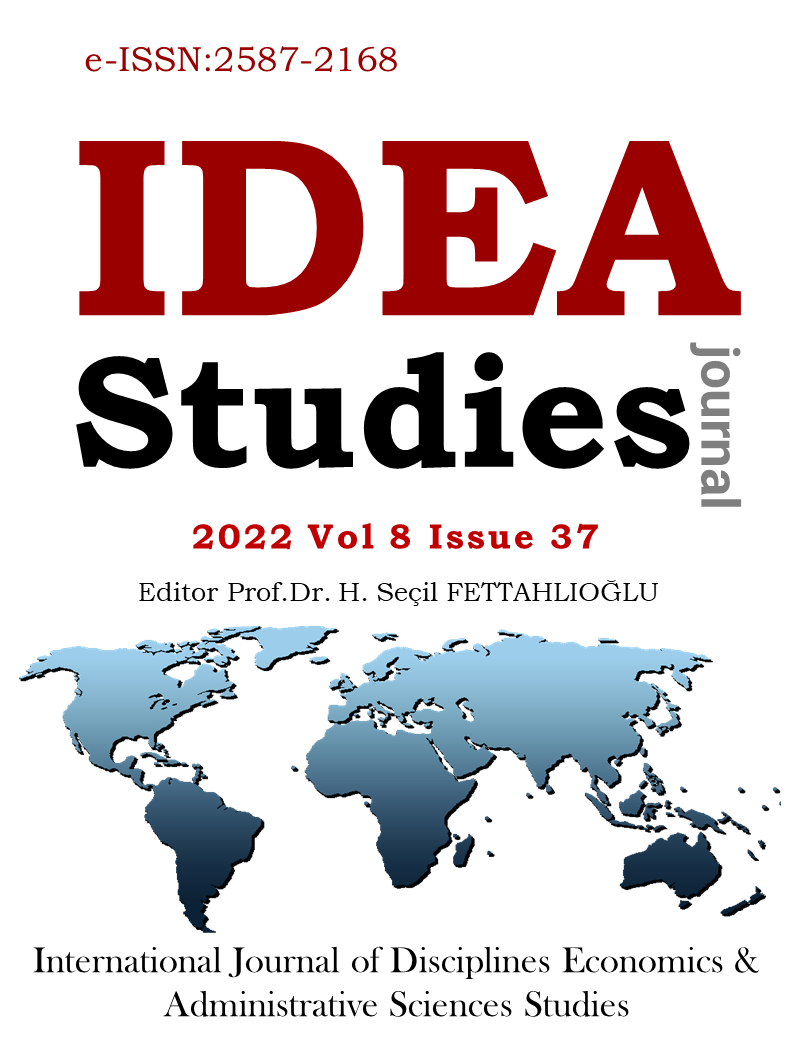Eskişehir’den Tüm Dünyaya Mutluluk Dağıtan “Eti Baba” Firuz Kanatlı’nın Liderlik Özelliklerinin İncelenmesi
Author :
Abstract
Sürekli değişen ve gelişen çevrelerde liderlik özelliklerinin zamanla değişmesi liderlik kavramını özellikle yönetim literatüründe güncel bir konu olarak tutmaktadır. Çalışma Orta Anadolu’da kurduğu bisküvi fabrikasıyla tüm dünyada adından bahsettiren Eti firmasının kurucusu Firuz Kanatlı’nın liderlik özelliklerinin belirlenmesini amaçlamaktadır. Çalışmada nitel yöntemlerden doküman incelemesi ile toplanan veriler içerik analizine tabi tutulmuştur. Çalışma sonucunda Firuz Kanatlı’nın liderlik özellikleri “paternalistik özelliklere sahip olma”, “vizyon sahibi olma”, “demokratik olma”, “işbirlikçi yöne sahip olma” ve “rakiplere ve çevreye duyarlılık” şeklinde beş başlıkta toplanmıştır.
Keywords
Abstract
The fact that leadership characteristics change over time in constantly changing and developing environments keeps the concept of leadership as a topical issue, especially in the management literature. The study aims to determine the leadership characteristics of Firuz Kanatlı, the founder of Eti company, who mentioned his name all over the world with the biscuit factory he founded in Central Anatolia. In the study, the data collected by document review from qualitative methods were subjected to content analysis. As a result of the study, the leadership characteristics of Firuz Kanatlı were collected in five headings as “paternalistic characteristics”, “having a vision”, “being democratic”, “having a collaborative direction” and “being responsive to competitors and the environment”
Keywords
- Abbott, P. (1997). Leadership by Exemplar: Reagan's FDR and Thatcher's Churchill. Presidential Studies
- Abbott, P. (1997). Leadership by Exemplar: Reagan's FDR and Thatcher's Churchill. Presidential Studies Quarterly, 27(2), s. 186-206. https://www.jstor.org/stable/27551725 adresinden alındı
- Akyüz, M. (2018). Stratejik Liderlik. Stratejik Yönetim Araştırmaları Dergisi, 1(1), 45-66. Altun, M. (2012, Şubat). 50 Yılın Öyküsü. İstanbul: Ofset Yapımevi.
- Amanchukwu, N. R., Stanley, J. G., & Ololube, N. P. (2015). A Review of Leadership Theories, Principles and Styles and Their Relevance to Educational Management. Management, 5(1), 6-14.
- Avery, G. C. (2004). Understanding Leadership: Paradigms and Cases. ProQuest Ebook Central.
- Aycan, Z. (2001). Paternalizm: Yönetim ve Liderlik Anlayışına İlişkin Üç Görgül Çalışma. Yönetim Araştırmaşarı Dergisi, 1(1), 1-26.
- Aycan, Z. (2006). Paternalism: Towards Conceptual Refinement and Operationalization. K.-S. Y.-K. U. Kimiçinde, Indigenous and cultural psychology: Understanding people in context (s. 445–466). Springer Science + Business.
- Çetin, N. G., & Beceren, E. (2007). Lider Kişilik: Gandhi. Süleyman Demirel Üniversitesi Sosyal Bilimler Enstitüsü Dergisi, 3(5).
- etietieti.com. (2021). https://www.etietieti.com/ adresinden alındıEti'de Bir Ömür. (2010). Eskişehir: Eti Şirketler Grubu Yayınları.Ehrhart, M. G. (2004). Leadership and procedural justice climate as antecedents of unit-level organizational citizenship behavior. Personnel Psychology, 57(1), 61–94.
- Fettahlıoğlu, O.Ö., Özay, E. ve Akdoğan, Z. (2018), “The Effect of Visionary Leadership Style on Organizational Support Segment”, Atlas International Referred Journal On Social Sciences, 4(8), 183-199.
- Hersey, P., Blanchard, K. E., & Natemeyer, W. E. (1979). Situational Leadership, Perception, and the Impact of Power. Group & Organization Studies, 4(4), 418-428.
- Horner, M. (1997). Leadership theory: past, present and future. Team Performance Management, 3(4), 270-287.Ireland, R. D., & Hitt, M. A. (2005). Achieving and Maintaining Strategic Competitiveness in the 21st. Century: The Role of Strategic Leadership. Academyof Management Executive, 19(4), 63-74.
- Keskin, Y. (2002). Türk Siyasal Hayatında Bir Karizmatik Lider Örneği: Turgut Özal. İstanbul: Marmara Üniversitesi Sosyal Bilimler Enstitüsü.
- Köse, E. (2019). Blake & Mouton’ un Yönetim Ölçeği Yaklaşımı Perspektifinde Sakıp Sabancı'nın LiderlikAnalizi. İ. Elagöz, G. Erdoğan, A. Gezen, & A. Yılmaz içinde, Sosyal Bilimler Alanında Araştırma Makaleleri. Gece Akademi.
- Özdemir, M. (2010). Nitel Veri Analizi: Sosyal Bilimlerde Yöntembilim Sorunsalı Üzerine Bir Çalışma. Eskişehir Osmangazi Üniversitesi Sosyal Bilimler Dergisi, 11(1), 323-34.
- Page, D., & Wong, P. (2000). Conceptual Framework for Measuring Servant Leadership. A. S. içinde, The Human Factor in Shaping the Course of History and Development. University Press of America.
- Lamb ,R. (2013). How can Managers Use Participative Leadership Effectively?
- McShane, S. L., & Von Glinow, M. A. (2016). Organizational behavior. New York, NY: McGraw-Hill.
- Sarı, E. (2020). Vizyoner Liderlik: Mithat Paşa Örneği. Uluslararası Liderlik Çalışmaları Dergisi: Kuram ve Uygulama, 75-86. https://dergipark.org.tr/en/pub/ijls/issue/58738/749075 adresinden alındı
- Sharma, A., & Grant, D. (2011). Narrative, Drama and Charismatic Leadership: The case of Apple’s Steve Jobs. Leadership, 7(1), s. 3-26.
- Shelton, E. (2012). Transformational Leadership: Trust, Motivation and Engagement. Trafford Publishing.
- Subramaniam, R., & Heaton, D. P. (2020). A Qualitative Examination of the Leadership Traits of Ram from Srimad Valmiki Ramaya. 1.
- Toma, S.-G., & Marinescu, P. (2013). Steve Jobs and Modern Leadership. Manager, 17, s. 260-269. https://www.proquest.com/scholarly-journals/steve-jobs-modern-leadership/docview/1518528902/se-
- Topbaş, M. E., & Yiyit, T. (2019). Güler Sabancı’nın Liderlik Özellikleri: Nitel Bir Araştırma. 7. Örgütsel Davranış Kongresi (s. 671-680). Burdur: Burdur Mehmet Akif Ersoy Üniversitesi.
- Uğurluoğlu, Ö., & Çelik, Y. (2009). Örgütlerde Stratejik Liderlik ve Özellikleri. Hacettepe Sağlık İdaresi Dergisi, 12(2).
- Vroom, V. H., & Yetton, P. (1973, December). Leadership and Decision-Making. Administrative Science Quarterly, 18((4)).
- Winston, B. E., & Dennis, R. (2003). A Factor Analysis of Page and Wong’s Servant Leadership Instrument.Leadership & Organization Development Journal, 24(8), 455-459. doi:https://doi.org/10.1108/01437730310505885
- Yıldırım, A., & Şimşek, H. (2013). Sosyal Bilimlerde Nitel Araştırma Yöntemleri. Ankara: Seçkin Yayıncılık.





